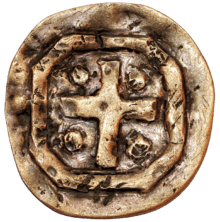Curmsun Disc

Curmsun Disc is a concave golden disc of a weight of 25.23 grams (0.890 oz) and a diameter of 4.5 centimetres (1.8 in). The Danish Viking king, Harald Bluetooth, is mentioned in the inscription of the disc. Curmsun is the latin version of the king's birth name Gormson.
Origin
The Curmsun disc was part of a Viking hoard discovered in a medieval crypt in 1841. The crypt was unearthed at a new building construction site on the east bank of the river Dziwna, some kilometers east of Wolin, near the place where the semi-legendary Viking stronghold of Jomsborg stood between the 960s and 1043. The discovery was made by Heinrich, a Prussian boy, who some years later emigrated to New York and changed his name to Henry Boldt. The Curmsun disc was left in the crypt and fell into oblivion until 1945 when a Polish army major, Stefan Sielski, and his brother Michal, entered the crypt and seized what was left of the Viking hoard of 1841.[1] The Disc did not appear to be made of gold and was thus placed in a box with old buttons. It took 69 more years before scientists finally got the possibility to examine the disc. It happened in 2014 when Michal Sielski's 11-year-old great-granddaughter found the box and brought the disc to her history teacher and had it later examined by a prominent Swedish archaeologist Sven Rosborn.[2]
Interpretation

Researchers have interpreted the inscription on the obverse as: "+ARALD CVRMSVN+ REX AD TANER+SCON+JVMN+CIV ALDIN+".
A translation of the inscription reads: "Harald Gormsøn king of Danes, Scania, Jomsborg, town Aldinburg (Oldenburg in Holstein)".
On the reverse there is an octagonal ridge, which runs around the edge of the object. In the center of the octagonal ridge there is a Latin cross. There are four dots around the Latin cross. Similar dot markings are common on coins, even on coins from the late 900s. The four dots could possibly symbolize the four evangelists, whose symbols in the Middle Ages had strong associations with the Christ symbolism of the cross.[3]
Dating Theories
Around 960s - Harald Bluetooth's Second Marriage
Danish anthropologist, Karen Schousboe, believes that the Curmsun Disc could have been a wedding gift during Harald Bluetooth´s second marriage, created in the 960s. K. Schousboe also sees a connection to 10th-12th century Byzantine talismans.[4]
Around 985 - Harald Bluetooth´s Golden Seal
Pontus Weman Tell has a theory that the Curmsun Disc had been ordered as a golden seal by Theophanu to confirm or reinstall Harald Bluetooth on the throne. Through a philological analysis he concludes that the disc has most likely been produced before the introduction of the g-rune as Gormson is transliterated as CVRMSVN and not as GVRMSVN. Furthermore, the use of Old Norse like the word Taner on the Curmsun Disc ends in coin inscriptions in the beginning of the 11th century which strengthens a manufacturing date before year 1000. Empress Theophanu who officially took over regency in the Holy Roman Empire in 985 could have ordered the Curmsun Disc as a decree to confirm or reinstall Harald on the throne to safeguard her minor son´s interest.[5]
Around 986 - Harald Bluetooth's Death
According to a theory by Swedish archeologist Sven Rosborn the Curmsun Disc may have been created by a Frankish monk in connection with Harald Bluetooth´s death.[6]
Around 1100 – Harald Bluetooth Canonized?
According to a theory in an article in the magazine Siden Saxo (published by Danish State Archives) written by Danish archivist Steffen Harpsøe the disc may have been created by local priests around Jomsborg and Wiejkowo between 1050-1125. There is a possibility that the missionaries in the area canonized Harald Bluetooth and made the Curmsun Disc as a symbolic ornament. S. Harpsøe sees a connection between the Curmsun Disc and Byzantine seals and coins where the inscription are made in horizontal lines and the form could be concave.[7]
Authenticity
Metallurgical Analysis
The Curmsun Disc underwent electron microscopic analysis at Lunds University in Sweden. The analysis showed a non-homogeneousthat alloy and a gold content ranging between 83,3-92,8%. The surface and alloy showed characteristics typical for artifacts created during the latest part of early middle ages. No traces of modern processes or chemicals were neither discovered. Surface analysis by a gemologist, Jonny Westling,[8] appointed by Swedish Chamber of Commerce and Lloyds/Brookfield Underwriting, showed natural inclusions and patination.[9]
Reference Objects
The find consists of five objects today: a silver coin from Otto I's reign, a bracelet in bronze with a dash decoration covering the surface, a fragment of another bronze bracelet, a small stamped piece of gold and the Curmsun Disc itself.[10]
Exhibition
The Curmsun disc is owned by an undisclosed company and deposited at a bank vault in Sweden. The disc's insured value is $3,5 million and the valuation has been performed by Jonny Westling, an expert appointed by Swedish Chamber of Commerce and Lloyds/Brookfield Underwriting. It is now expected that the disc will be handed over to a museum or to a private collector.[11]
See also
References
- ↑ The Curmsun Disc website – The Story
- ↑ Zyśk, Daniel Polish Press Agency, Science and Scholarship, 2014
- ↑ Rosborn, S. (2014) A unique object from Harald Bluetooth´s time? Malmö: Pilemedia, pp. 4-5
- ↑ Schousboe, K. (2014) Harold Bluetooth’s Talisman – A Sensational Find? Or Fake? Medieval Stories
- ↑ Weman, P. (2016) The Curmsun Disc - Harald Bluetooth´s Golden Seal? Academia.edu
- ↑ Rosborn, S. (2014) A unique object from Harald Bluetooth´s time? Malmö: Pilemedia, pp. 10-11
- ↑ Harpsøe, S. (2015), Haraldsguldet – en mystisk guldskive fra fortiden, Siden Saxo No. 4 - 2015, Odense: Syddansk Universitetsforlag, ISSN 0109-6028, pp. 25-27
- ↑ Jonny Westling (2015) Westling Värdering AB
- ↑ The Curmsun Disc website – Metallurgical Analysis
- ↑ Rosborn, S. (2014) A unique object from Harald Bluetooth´s time? Malmö: Pilemedia, p. 1
- ↑ The Curmsun Disc website – News